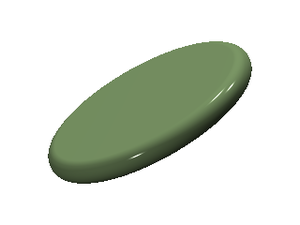Oblate hard spherocylinders: Difference between revisions
Jump to navigation
Jump to search
Carl McBride (talk | contribs) m (Added a publication) |
Carl McBride (talk | contribs) m (→References: Added a recent publication) |
||
| (2 intermediate revisions by 2 users not shown) | |||
| Line 20: | Line 20: | ||
;Related reading | ;Related reading | ||
*[http://dx.doi.org/10.1103/PhysRevE.49.3179 J. Šedlbauer, S. Labík, and A. Malijevský "Monte Carlo and integral-equation studies of hard-oblate-spherocylinder fluids", Physical Preview E '''49''' pp. 3179-3183 (1994)] | *[http://dx.doi.org/10.1103/PhysRevE.49.3179 J. Šedlbauer, S. Labík, and A. Malijevský "Monte Carlo and integral-equation studies of hard-oblate-spherocylinder fluids", Physical Preview E '''49''' pp. 3179-3183 (1994)] | ||
*[http://dx.doi.org/10.1080/08927020902833111 Bruno | *[http://dx.doi.org/10.1080/08927020902833111 Bruno Martinez-Haya and Alejandro Cuetos "Simulation study of discotic molecules in the vicinity of the isotropic-liquid crystal transition", Molecular Simulation '''35''' pp. 1077-1083 (2009)] | ||
*[http://dx.doi.org/10.1080/00268976.2011.649794 L. Wu, H.H. Wensink, G. Jackson and E.A. Müller "A generic equation of state for liquid crystalline phases of hard-oblate particles", Molecular Physics '''110''' pp. 1269-1288 (2012)] | |||
*[http://dx.doi.org/10.1080/00268976.2013.771802 Francisco Gámez, Rafael D. Acemel and Alejandro Cuetos "Demixing and nematic behaviour of oblate hard spherocylinders and hard spheres mixtures: Monte Carlo simulation and Parsons–Lee theory", Molecular Physics '''111''' pp. 3136-3146 (2013)] | |||
[[Category: Models]] | [[Category: Models]] | ||
Latest revision as of 14:51, 21 February 2014

The oblate hard spherocylinder model [1], also known as a discotic spherocylinder, consists of an impenetrable cylinder, surrounded by a torus whose major radius is equal to the radius of the cylinder, and whose minor radius is equal to half of the height of the cylinder. In the limit of zero diameter the oblate hard spherocylinder becomes a hard sphere, and in the limit of zero width one has the hard disk. A closely related model is that of the hard spherocylinder.
Overlap algorithm[edit]
An overlap algorithm is provided in the appendix of [2].
Excluded volume[edit]
Virial coefficients[edit]
Isotropic-nematic transition[edit]
Isotropic-nematic phase transition [6].
Columnar phase[edit]
Oblate hard spherocylinders form a columnar phase [7]
See also[edit]
References[edit]
- ↑ M. Wojcik and K. E. Gubbins "Thermodynamics and structure of hard oblate spherocylinder fluids", Molecular Physics 53 pp. 397-420 (1984)
- ↑ Matthieu Marechal, Alejandro Cuetos, Bruno Martínez-Haya, and Marjolein Dijkstra " Phase behavior of hard colloidal platelets using free energy calculations", Journal of Chemical Physics 134 094501 (2011)
- ↑ Bela M. Mulder "The excluded volume of hard sphero-zonotopes", Molecular Physics 103 pp. 1411-1424 (2005)
- ↑ I. Nezbeda and T. Boublík "Hard oblate spherocylinders: Monte carlo virial coefficients", Czechoslovak Journal of Physics 27 pp. 953-956 (1977)
- ↑ W. R. Cooney, S. M. Thompson and K. E. Gubbins "Virial coefficients for the hard oblate spherocylinder fluid", Molecular Physics 66 pp. 1269-1272 (1989)
- ↑ F. Gámez, P.J. Merkling and S. Lago "Parsons–Lee approach for oblate hard spherocylinders", Chemical Physics Letters 494 pp. 45-49 (2010)
- ↑ Alejandro Cuetos and Bruno Martínez-Haya "Columnar phases of discotic spherocylinders", Journal of Chemical Physics 129 214706 (2008)
- Related reading
- J. Šedlbauer, S. Labík, and A. Malijevský "Monte Carlo and integral-equation studies of hard-oblate-spherocylinder fluids", Physical Preview E 49 pp. 3179-3183 (1994)
- Bruno Martinez-Haya and Alejandro Cuetos "Simulation study of discotic molecules in the vicinity of the isotropic-liquid crystal transition", Molecular Simulation 35 pp. 1077-1083 (2009)
- L. Wu, H.H. Wensink, G. Jackson and E.A. Müller "A generic equation of state for liquid crystalline phases of hard-oblate particles", Molecular Physics 110 pp. 1269-1288 (2012)
- Francisco Gámez, Rafael D. Acemel and Alejandro Cuetos "Demixing and nematic behaviour of oblate hard spherocylinders and hard spheres mixtures: Monte Carlo simulation and Parsons–Lee theory", Molecular Physics 111 pp. 3136-3146 (2013)